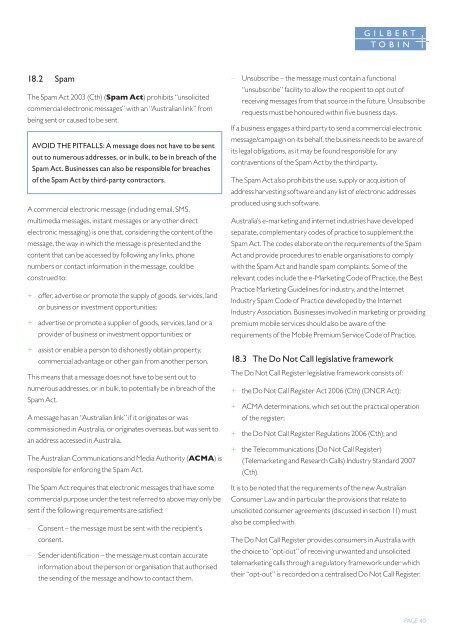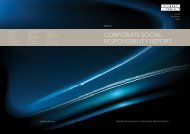Gilbert + tobin
Gilbert + tobin
Gilbert + tobin
- No tags were found...
Create successful ePaper yourself
Turn your PDF publications into a flip-book with our unique Google optimized e-Paper software.
18.2 SpamThe Spam Act 2003 (Cth) (Spam Act) prohibits “unsolicitedcommercial electronic messages” with an “Australian link” frombeing sent or caused to be sent.Avoid the pitfalls: A message does not have to be sentout to numerous addresses, or in bulk, to be in breach of theSpam Act. Businesses can also be responsible for breachesof the Spam Act by third-party contractors.A commercial electronic message (including email, SMS,multimedia messages, instant messages or any other directelectronic messaging) is one that, considering the content of themessage, the way in which the message is presented and thecontent that can be accessed by following any links, phonenumbers or contact information in the message, could beconstrued to:+ + offer, advertise or promote the supply of goods, services, landor business or investment opportunities;+ + advertise or promote a supplier of goods, services, land or aprovider of business or investment opportunities; or+ + assist or enable a person to dishonestly obtain property,commercial advantage or other gain from another person.This means that a message does not have to be sent out tonumerous addresses, or in bulk, to potentially be in breach of theSpam Act.A message has an “Australian link” if it originates or wascommissioned in Australia, or originates overseas, but was sent toan address accessed in Australia.The Australian Communications and Media Authority (ACMA) isresponsible for enforcing the Spam Act.The Spam Act requires that electronic messages that have somecommercial purpose under the test referred to above may only besent if the following requirements are satisfied:––Consent – the message must be sent with the recipient’sconsent.––Sender identification – the message must contain accurateinformation about the person or organisation that authorisedthe sending of the message and how to contact them.––Unsubscribe – the message must contain a functional“unsubscribe” facility to allow the recipient to opt out ofreceiving messages from that source in the future. Unsubscriberequests must be honoured within five business days.If a business engages a third party to send a commercial electronicmessage/campaign on its behalf, the business needs to be aware ofits legal obligations, as it may be found responsible for anycontraventions of the Spam Act by the third party.The Spam Act also prohibits the use, supply or acquisition ofaddress harvesting software and any list of electronic addressesproduced using such software.Australia’s e-marketing and internet industries have developedseparate, complementary codes of practice to supplement theSpam Act. The codes elaborate on the requirements of the SpamAct and provide procedures to enable organisations to complywith the Spam Act and handle spam complaints. Some of therelevant codes include the e-Marketing Code of Practice, the BestPractice Marketing Guidelines for industry, and the InternetIndustry Spam Code of Practice developed by the InternetIndustry Association. Businesses involved in marketing or providingpremium mobile services should also be aware of therequirements of the Mobile Premium Service Code of Practice.18.3 The Do Not Call legislative frameworkThe Do Not Call Register legislative framework consists of:+ + the Do Not Call Register Act 2006 (Cth) (DNCR Act);+ + ACMA determinations, which set out the practical operationof the register;+ + the Do Not Call Register Regulations 2006 (Cth); and+ + the Telecommunications (Do Not Call Register)(Telemarketing and Research Calls) Industry Standard 2007(Cth).It is to be noted that the requirements of the new AustralianConsumer Law and in particular the provisions that relate tounsolicited consumer agreements (discussed in section 11) mustalso be complied with.The Do Not Call Register provides consumers in Australia withthe choice to “opt-out” of receiving unwanted and unsolicitedtelemarketing calls through a regulatory framework under whichtheir “opt-out” is recorded on a centralised Do Not Call Register.PAGE 40







